The first thing that baffles the pilgrims, coming to Puri is that everything associated with this place is expressed in superlatives. Like the God is Mahaprabhu, Goddess is MahaLaxmi, Lord Balabhadra is Badathakur, the temple is Badadeula, the sea is Mahodadhi and the Prasad offered to Lord is Mahaprasad and the kitchen where the food is cooked is treated as the biggest kitchen in the world. Indian subcontinent has four shrines which is declared as holiest of the holies as it is believed to have been liked by Lord Vishnu intimately.
They have been christened as Dham (Abode of Lord). These places are Rameswar in south, Dwarika in west, Badrinath in north and Puri in east. It is believed that He takes His bath at Rameswaram, meditates at Badrinath, dines at Puri and retires at Dwarika. Therefore, a lot of importance is given to the Mahaprasad at Puri.
Skanda Purana, the scripture on Lord Jagannath explains the value of Mahaprasad in eloquent words. All sins are destroyed when Mahaprasad is taken even if it is stale, dried and brought from a long distance. There is reference to the kitchen and preparation of Mahaprasad in the Madala Panji, regarded as the chronicle of the temple.
There are 26 old scriptures (Puranas) where the Mahaprasad has been held in high esteem. It has been said that partaking Mahaprasad is equivalent to having Darshan of Lord Jagannath. By partaking Mahaprasad all sins are washed away. Having Mahaprasad one gets salvation after death. Mahaprasad is so powerful that irrespective of caste, creed and sex all can eat together form one pot.
It is said that Goddess Mahalaxmi herself cooks in the kitchen and she cooks four dishes such as Bhima Paka, Nala Paka, Souri Paka and Gouri Paka for Lord Jagannath in disguise and it is prepared in most sacred manner. Cooks in the Roshaghara are considered as representatives of Maa Lakshmi. Goddesses Dakshina Kali supervises or protector of the kitchen. Only suara, Mahasuara and Pujapanda are allowed inside Roshaghara. Suara Sevaka ( cooks) enter kitchen only after worshipping and putting the tilak or sindhoora of Dakshina Kali. Another important Devatha is Lord Ganesha. Before entering Roshaghara, cooks pray Lord Ganesha who is the remover of hurdles for the smooth preparation of Naivedya for Lord Jagannath.
The kitchen fire is called Vaisnavagni, because it is the fire in the kitchen of Lord Jagannath are used to serve Vishnu Himself, it is never put out. Charcoals are kept burning day and night by one worshipper called Akhand Mekap.
Another name of Mahaprasad is called Kaibalya that which gives Mokshya, salvation or liberation. It is said that, if one takes this food of Lord Jagannath, he will have no rebirth.
Everyday after Bada Singhara Bhoga of Mahaprabhu which is the last Bhoga of the day, 3 types of sevayath Dhruva pakala, Gobara pania, Rabadia enter the Roshaghara entire leftover dravya or things like water, salt turmeric, rice are removed from kitchen. Used pots are broken and new pots are used for the next day cooking. The whole kitchen is cleaned with water. All chulas ( stoves) are washed with water and apply fresh cow dung on chulas. In the morning after Mangala Aarti, Abakasha and Besha Pujapanda is informed that kitchen is clean and they can start the Roshahoma. In a specific place where kotha Bhoga is prepared, the Roshahoma takes place. The fire from the chula of previous day is used for the Homa. After the completion of the Homa around 8’0clock to 8-30 am preparation of cooking like washing the rice, cutting vegetables everything starts. After GopalaVallabha Bhoga around 9-30 cooking on fire starts for Sakala Dhupa and cooks get 45 minutes in which they prepare 20 types of pitha, khechudi, Oria, bhaja, Saga, Adda Pachadi etc.
Story behind how it becomes Mahaprasad after offering to Goddesses Bimala
According to Nilachala Mahatmya texts, Narada was eager to taste Mahaprasad and came disguised as a woman. Lakshmi recognised him and offered him some. Another tale mentions Krishna was having his meal in Brajadhama, and Narada had also joined him. When Narada reached Kailash, a particle of the food was still clinging to his beard which Shiva gladly ate. When his consort Gauri wanted a bit, Lord Shiva did not give her. When Gauri asked for it from Lord Krishna, the latter assured her that she would appear as Goddess Vimala in Kali Yug and would have the opportunity then.
Even today the taste of Mahaprasad cannot be duplicated outside. It is also the direct experience of devotees inside the temple that when the cooked food is carried from kitchen to the temple it has no fragrance, no sweet aroma but after the offering Maa Vimala when it is carried from the temple to Anand Bazar, the place of sale smelled divinely sweet.
Types of Mahaprasad:
There are three types of Mahaprasad.
- Sankhudi ( cooked) or Abadha Mahaprasad includes items like rice, ghee rice, mixed rice and dishes like dal, plain dal mixed with vegetables, mixed curries of different types of leafy vegetables porridge etc.
- Nisankhudi or dry Mahaprasad consists of dry sweetmeat and cakes like khaja made of maida, Gaja made of wheat flour, Ladoo made of wheat, sugar and ghee, kanti, rice flour and ghee, Chakuli, Puli, Nadi, Nadu, Chadheineda, Manohara, jhilli, Arisa, ballabha, malpua, mathapuli etc. During Rath yatra when deities are on Ratha only Nisankhudi bhog is offered to lords and no rice items or Sankhudi Mahaprasada is offered.
- Nirmalya:-Besides Sankhudi and Sukhila Mahaprasad, another type of dry Mahaprasad is called Nirmalya. In spiritual recognition Nirmalya is equally important as Mahaprasad. Nirmalya is commonly understood as dry rice i.e. cooked rice dried up in hot sun inside a separate place earmarked for drying. This is further packed in small cloth bags. In the absence of Sankhudi or Sukhila Mahaprasad, Nirmalya is treated at par and is invariably found in every Hindu’s house as it is needed on all occasions.
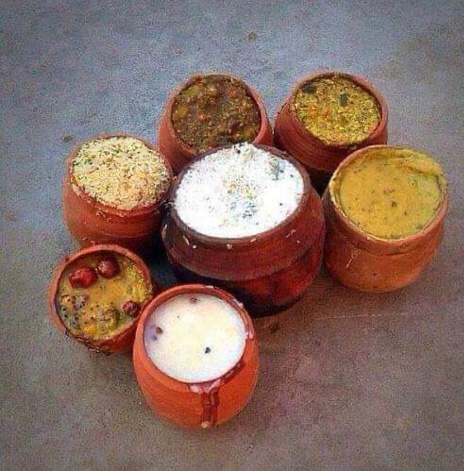
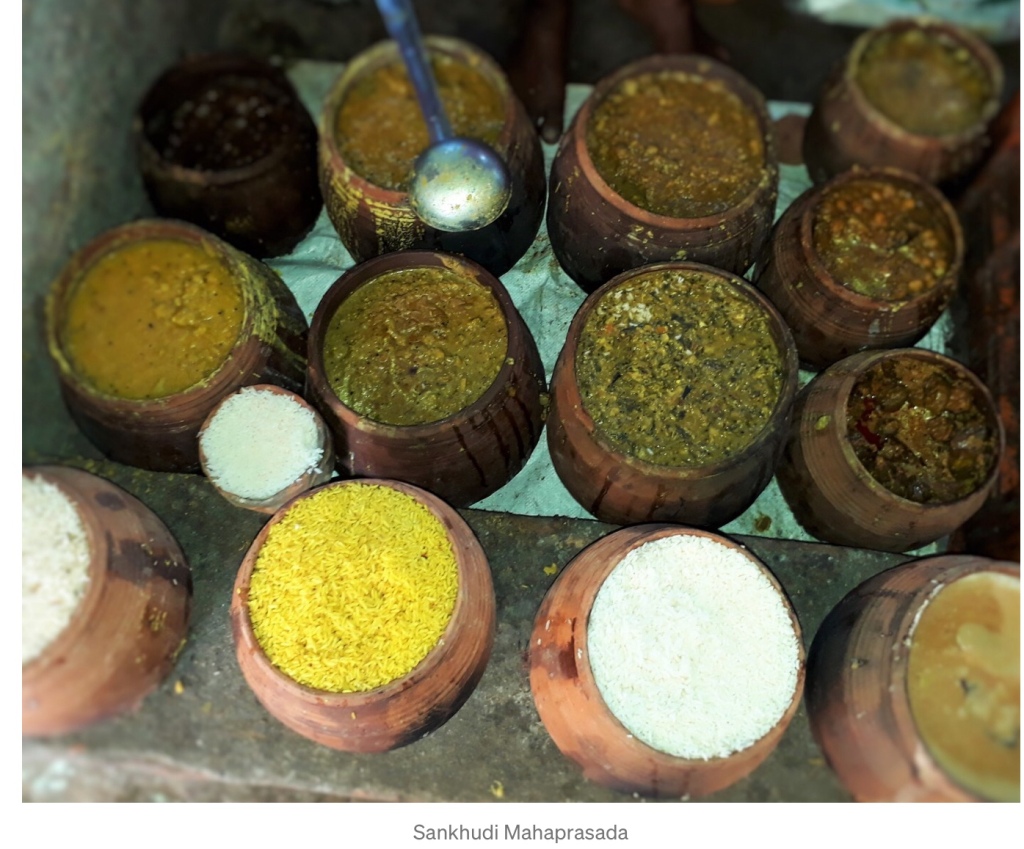
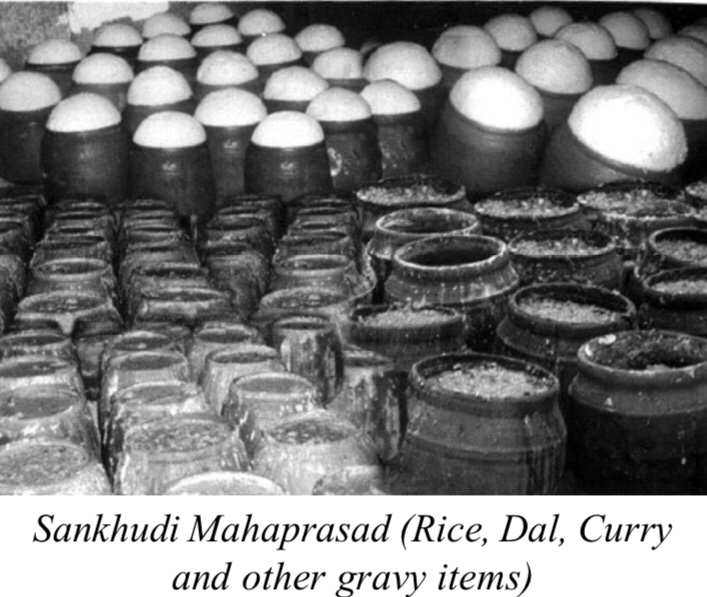
From the Madalapanji, it is evident that, the Sankhudi Bhoga was in place during the ruling of king Jajati Keshari. However, King Ananga Bhimadeva included many other items in the Lord’s platter. The legend says that, the Mahaprasad was first prepared in the Gundicha temple on the 9th day of Asadha Suklapaksha. In memory of that, every year on Asadha sukla paksha nabami, a tradition of having Mahaparasada in Gundicha temple is being celebrated. During the Moghul invasion from 1568 AD to 1575 AD, Mahaprasada could not be offered to the trinity. However, since 1751 AD, the Mahaprasada is being offered without fail with all devotion and tradition.
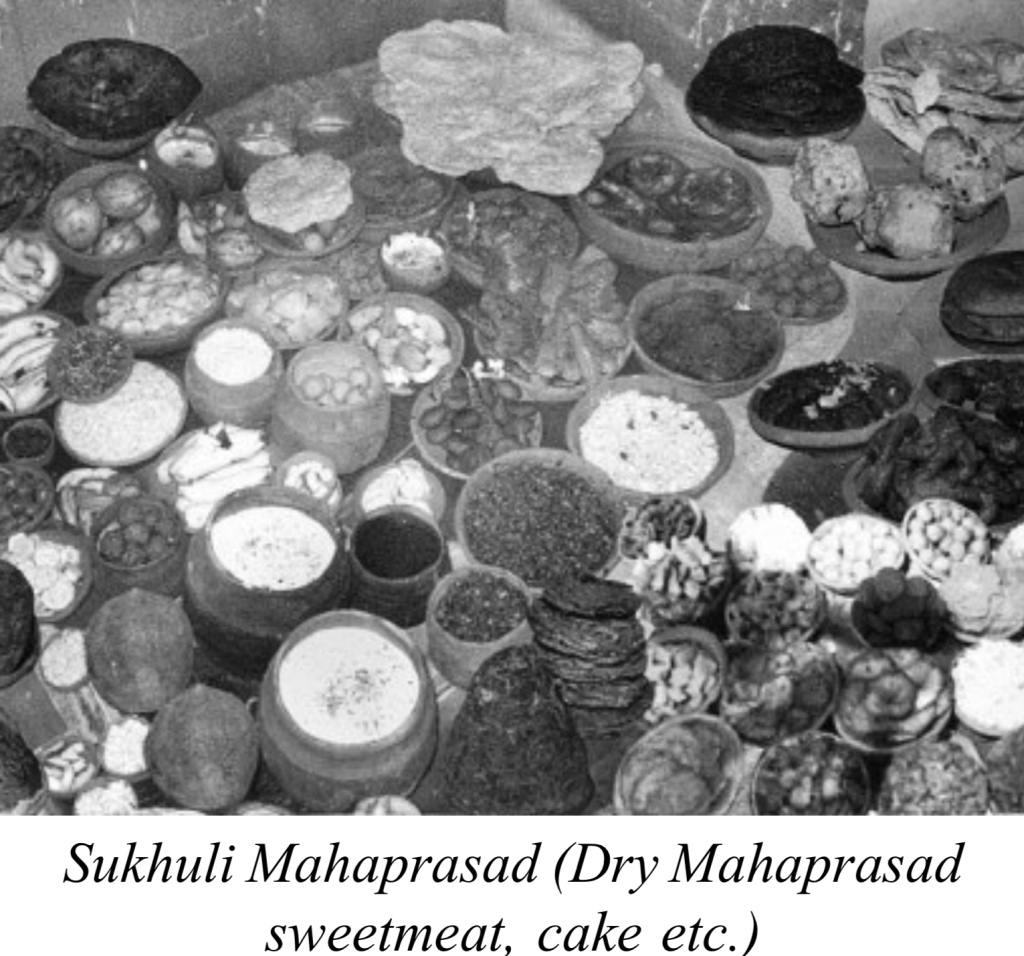
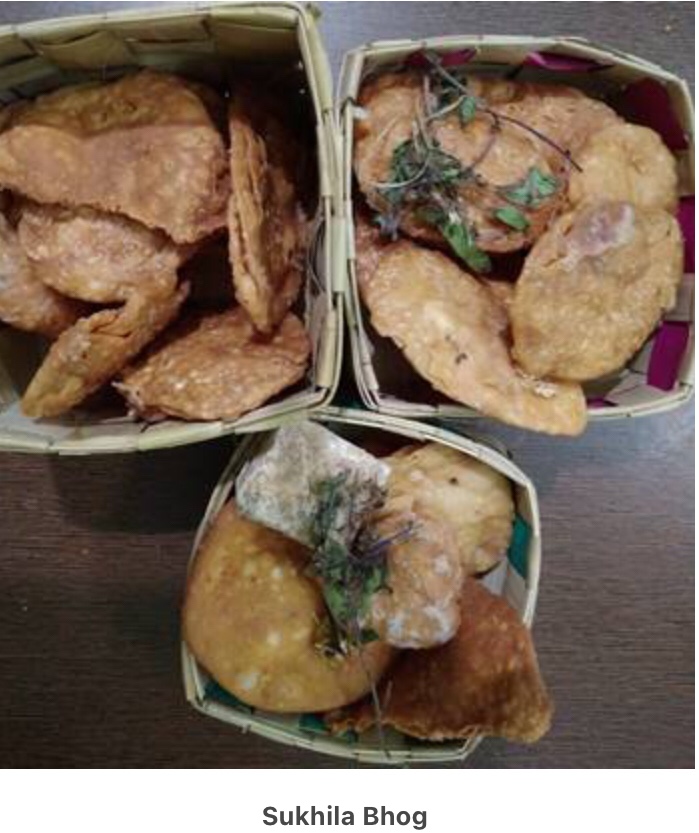
The Holy kitchen
The temple kitchen of Lord Jagannatha is situated in the east south corner of Meghnad Pracheri. In old days, this kitchen was situated on the back side of Satyanarayana temple. At that time, the quantity was small. The tradition of Mahaprasad began during the reign of King Yayati Keshari. It was disrupted for some years because the temple was defiled by invaders and then it resumed the tradition. The present kitchen is built during the period of Sri Dibyasimha Deba(1682–1713). A roof from temple kitchen to Bhogo mandapa was built during the time of King Harekrushna Deba(1720–25).
The offerings are made in the bhog mandapa, about 200 feet from the Ratna Vedi. This is called Chatra Bhog which was introduced by Adi Shankaracharya in the 8th century to help pilgrims share the temple food.
The kitchen is divided in to three types:
1.kitchen for Kotha Bhoga(Government Bhoga)
2.Kitchen for common bhoga
3. Kitchen specially for cakes
The prasada offered in kothabhog are distributed among sevayats
(as khei) for their respective functions in the temple. Prasada offered in bhogomandapa is available to pilgrims and local public.
Cooks collect the materials for bhoga from Mahalaxmi Bhandara (a store inside the temple) by paying the requisite costs.
The kitchen has a length of 150 ft, breadth of 100 ft & height of 20 ft and situated in south east direction of the outer compound of temple. There are 250 earthen chulas (earthen stoves) in the kitchen. In the kitchen 3 types of hearths are found such as “Anna Chuli”, Pitha Chuli” & “Tuna chuli” or Ahia. At a time 9–12 earthen pots. For cooking Rice only there are175 hearths, for Dal and curry 45 hearths and for preparing cakes and other dry Mahaprasad 20 hearths are used. Near about 500 people work daily in the temple kitchen. They engage 1500 people as helpers.
The present kitchen of Jagannatha is made of 32 rooms and a total of 752 stoves, producing 5,000 kg of food every day. During some special festival time, like in Kartika, the daily amount arrives at 10,000 kg.
About 600 cooks work in Jagannatha’s kitchen every day, of whom 200 are Suar, who actually cook the preparations on the fires, 200 are Joganya, who help the chefs by lighting the fires, washing the pots and utensils, fetching water etc, and 200 are Tunya, who work in a special area called agana in front of the kitchens by cutting vegetables and fruits, grinding coconut, spices, grains for flours etc. The masala (spice mixtures) are always prepared fresh, grinding together on stones the dry uncooked ingredients, sometimes with a little water or ghi to obtain a paste. The temple standards are very conservative: no gas or kerosene is used (everything is cooked on wood stoves) and only a limited variety of ingredients are allowed.
So in the Mahaprasadam in Puri you will never find potatoes, tomatoes, cauliflowers, cabbage, peas, capsicum, chilli or coriander, cucumber, karela, bhindi, green beans, beans, or parboiled rice. The pumpkin used in the recipes is a local indigenous variety.
A number of preparations are also banned from Jagannatha’s kitchen, notably panir (pressed cottage cheese) and chapati (roti), although one type of chapati (called khali roti) is prepared with boiled flour and puri are regularly offered. The most popular item in Jagannatha’s kitchen, however, are pancakes (called pithas), of many different types.
The ingredients used are as follows:
- vegetables: muli, patola, johni, desi alu, khanda mula, saru, kankana, plantain (green banana), spinach, pumpkin, eggplant, mango flowers, tala flowers,
- fruits: coconut, amla, tala fruit, banana, mango, apple, grapes, sitaphal, chikku, guava, orange (tangerine), raisin,
- spices and condiments: ginger, black mustard seeds, cardamom, red cardamom, cinnamon, black pepper, ajwain, nutmeg, cloves, gur (unrefined cane sugar), white sugar,
- pulses and grains: urad dal, harar dal, mung dal, chickpeas, besan (chickpea flower), atta (whole wheat flour), maida (white wheat flour),
- milk products: milk, dahi (yogurt), makhana (butter), chenna (fresh cottage cheese), rabri (creamy cooked down milk), khua (solid cooked down milk), khiri (milk and rice pudding), ghi (clarified butter).
The hearths have six corners and the fire is lighted on the Nab chakra yantra according to tantric invocations  and nine earthen pots are arranged at a time on the chullah. Cooking involves only steaming. Earthen pots are used for steaming ingredients and discarded after one use. The amazing fact is that the uppermost pot gets cooked first then the lower pots.
Simultaneously, 752 chullahs are used to cook the meal. The chullahs are quite big, 4 by 2 and a half feet in diameter and are 2 feet in depth. The middle portion is called Acchia where charcoal is burnt to cook the dal and curry.
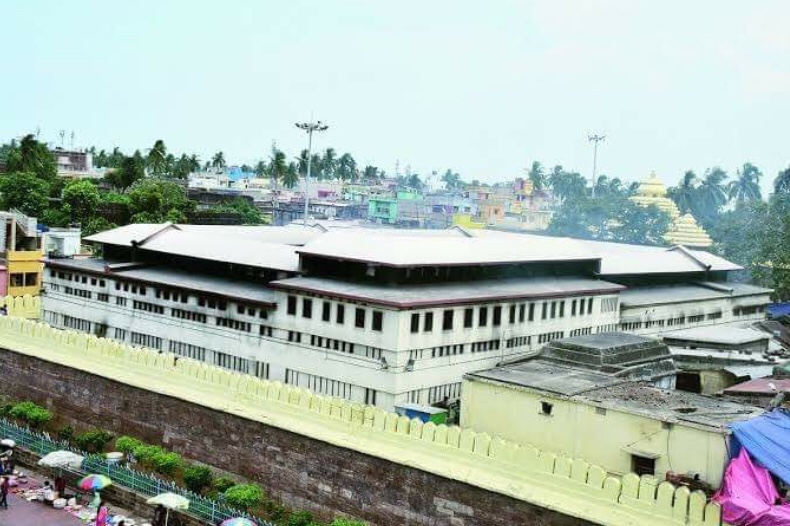
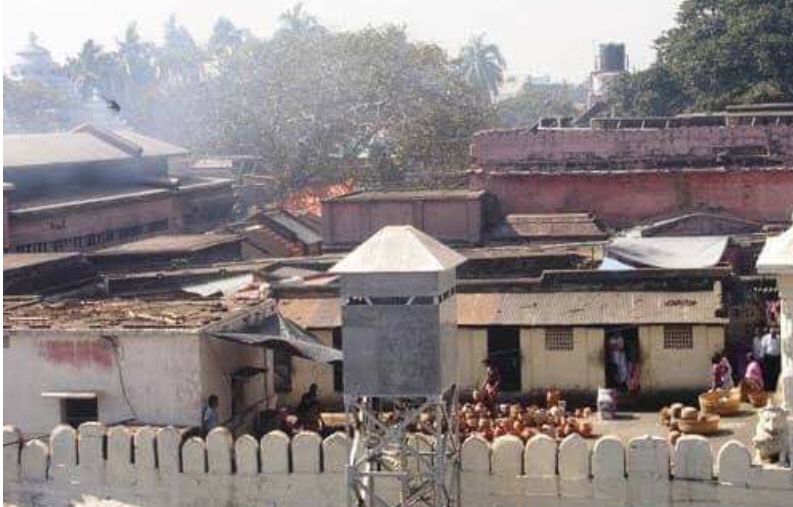
Water used in the kitchen
Water is drawn from two 100 -foot deep wells inside the temple premises towards the northern side of the kitchen. They are named as Ganga and Jamuna as per the two famous perennial rivers in India. These wells are very old, probably they were dug during the construction of the temple itself.
Four types of cooking procedure are followed in the kitchen of Srimandir: Bhimapaka, Nalapaka, Souripaka and Gouripaka
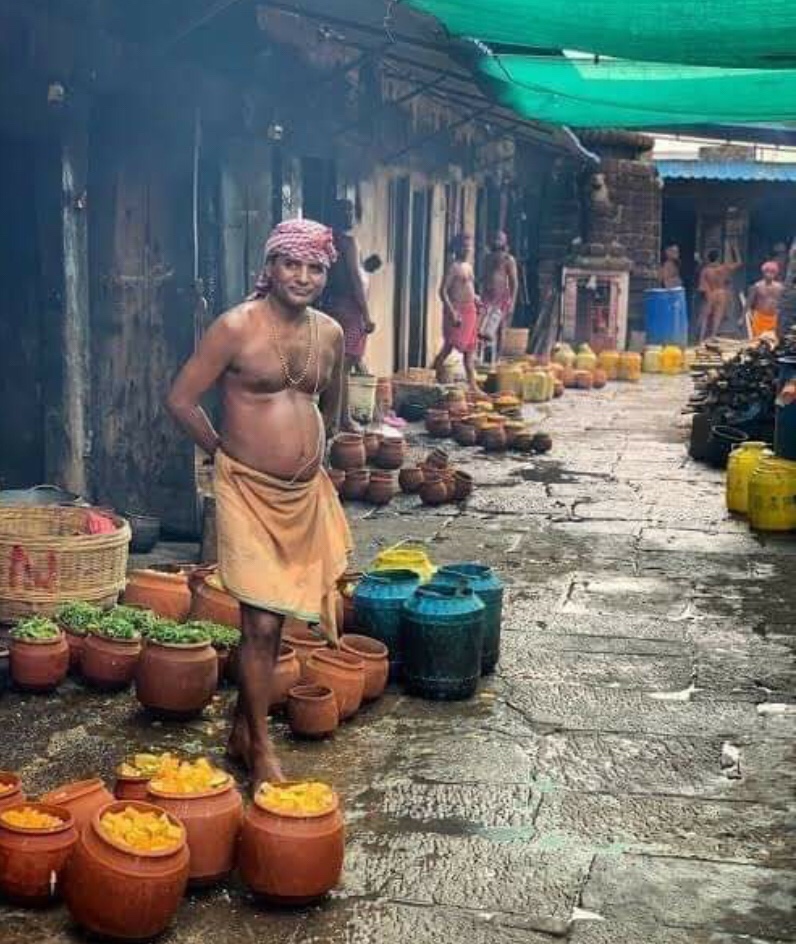
The items of Bhimapaka are Badatiana, Gudakhuara, Pakala Nadia Rasa, Purapitha,Biripitha and Gudakanji. In Nalapaka, items like Sakara, Tianlapara, Adanga and different types of sweet drinks are prepared. Souripaka items include Mahura, Deshialubhaja, Kadalibhaja, Adapachedi, Ghialabanga and varieties of cakes. In Gouripaka process, Mugatiana, Leutia, Kosala and Madhura Lalita Saga items are cooked. The cooked food is offered to Lord Jagannth first and then it is offered to Goddess Bimala, after which it becomes Mahaprasada.
Types of earthen pots used in the temple
Various types and size of earthen pots are used in the temple kitchen for cooking of food and also for selling and distribution of the Mahaprasad to the pilgrims.
There is a caste of servitors among the 36 types in the Puri temple called Kumbhakaras or potters, who provide the earthen pots called kudua and handi in which the Mahaprasad is available. The king of Puri had provided them with 143 acres of land for this purpose. They have a significant role to perform in the everyday cooking in the holy temple. And for that they recovered Khei or food for one meal. Â They make the earthen pots with utmost care.
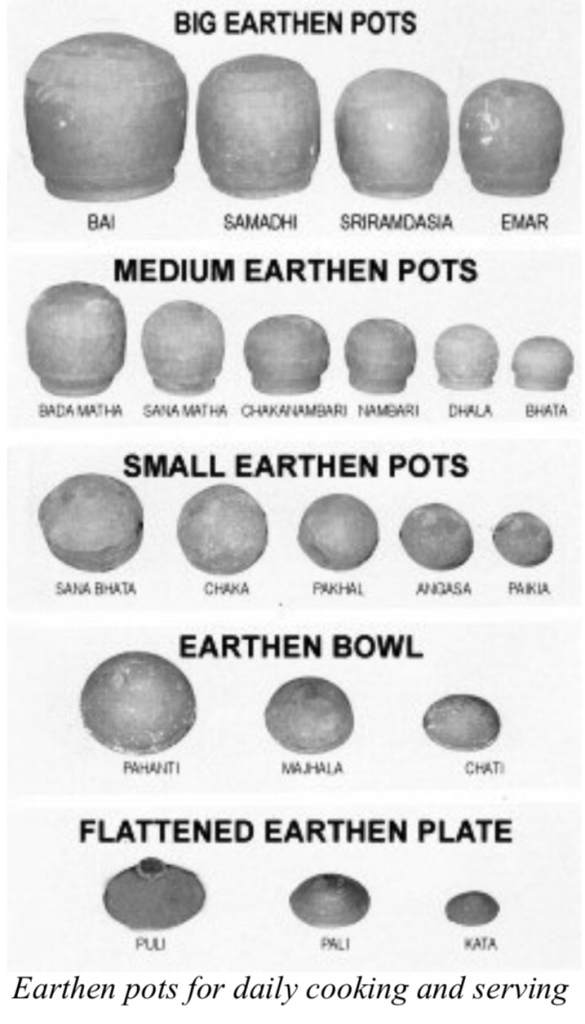
For the convenience of the pilgrims the earthen pots have been named like Karma Bai pot, Dasia Math pot, Samadhi pot, Emar pot, and Numbari pot etc. Each pot has the capacity to feed a specific number of average devotees on the basis of their average consumptions.
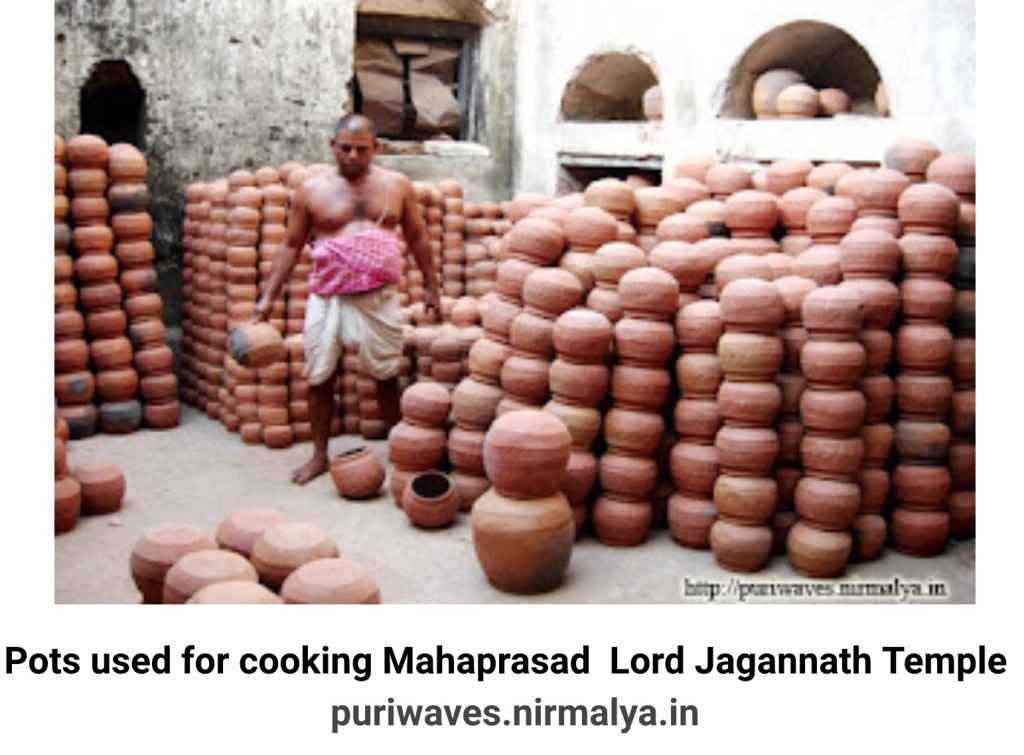
Why the colour of the earthen pot is red ?
The potters give the heat to the clay pots while making the pots ready for cooking. A longer period of heat treatment is given to make it black and a smaller time is required for making them red. It is believed that red pots are able to withstand heat and the cooking is done at a record possible time. In the hearth of Srimandira kitchen Rosha griha, in one hearth 9 (nine) pots are placed in a planned manner at a time for cooking and firewood is placed below the hearth for cooking. As per the ancient belief red colour is the symbol of Satwik culture which is very sacred in Hindu culture.
The Hearth (Fire oven)
There are three types of hearths (fire oven) in the kitchen of Srimandir. They are Bhata/ Anna Chuli, Pitha Chuli and Yagna kunda/ Ahia Chuli. In Srimandir 240 chuli is there. Just like 36 Niyoja works at Srimandir in the same way in Roshaghara also 36 Niyoja sevayath are engaged in different types of work.
Bhata/ Anna chuli is like open lotus flower ( very big). On this chuli 9 pots or handi is kept one over the other. In each handi 12,050 gm rice is kept, All gets cooked in 2 minutes. The topmost cooks the first.
Pitha Chuli which is like upside down of lotus flower.
Yagna kunda / Ahia Chuli in which Dali, Tarkari and others are prepared.
The dimension of the hearth where rice is prepared is known to be Anna Chuli is of length 3ft, breadth 2.5 ft and height 3.5 ft.7
Each hearth can accommodate 9 – 12 earthen pots at a time are kept on each hearth and food is slow cooked which is sufficient for 100 people. They are not dug out in the ground. At the base triangle shaped structures are built and firewood is placed inside it in two stages. Around 20 to 30 kg of firewood can be given at a time.
The other type of hearth is rectangular in shape which accommodates 27 earthen pots at a time. The sizes of this type of hearths are (9’ x 3’).Here the hearth does not need any firewood. These hearths are called Ahia chuli where the remnants of of burning wood from the rice hearth are used for preparing dal and other curry items. There are 45 numbers of Ahia ovens in the kitchen. The balance 20 hearths are used for preparation of cakes and other food items for the Raja Bhog or Kotha Bhog. The first two categories of hearth is basically meant for offering to Lord and then it is available for the devotees and visitors. The last category of hearths is for exclusive cooking for the Lord for different rituals starting from early morning to late night as per the pattern and tradition of rituals. This food after being offered to Lord is distributed among the ritual functionaries; it is a part of their remuneration and called as Khei. Normally 200 kgs of firewood is required daily for the preparation of kotha bhoga or raja bhoga.
Before the food is cooked, a Rosha Homa is performed using the rituals of the Vaishnava Agni Samskara, and this Vaishnava Agni or fire is used for starting the stoves. The clay stove used for the cooking is also constructed in a Tantric way as Satkonatmaka Agni Yantra, with six elevations to hold the pots. Then the Navachakra or nine cooking pots are placed on top of the Agni Yantra stove.
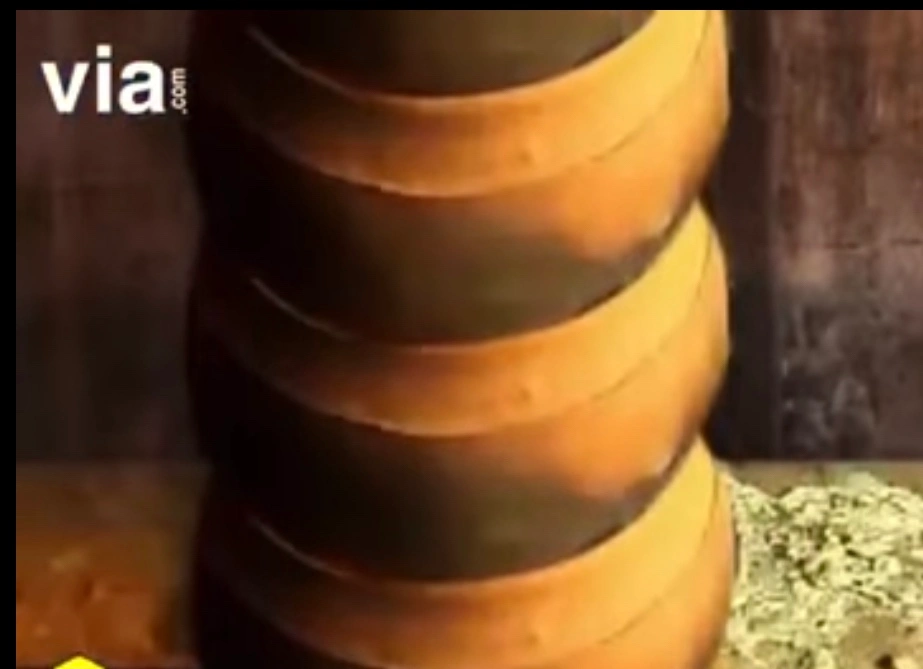
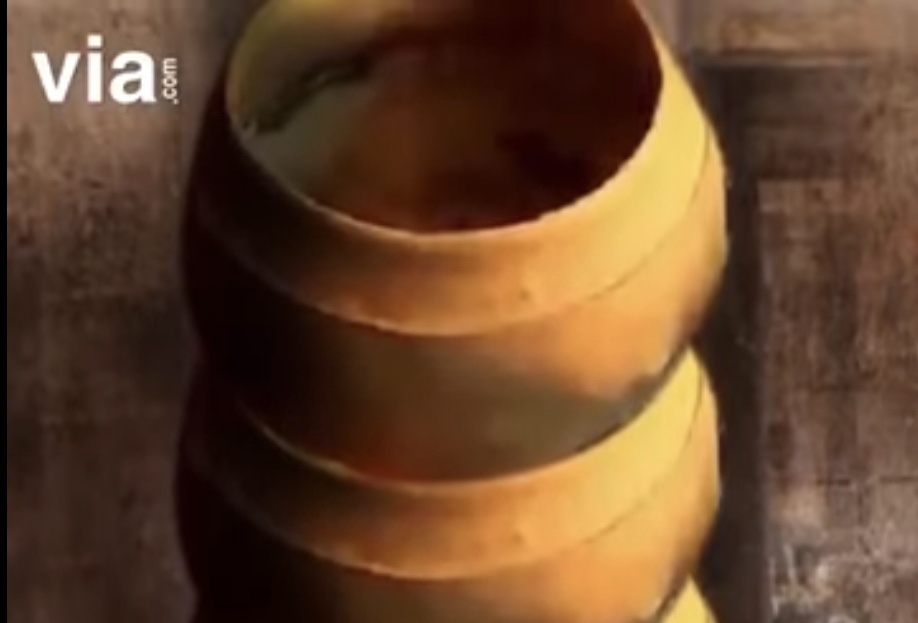
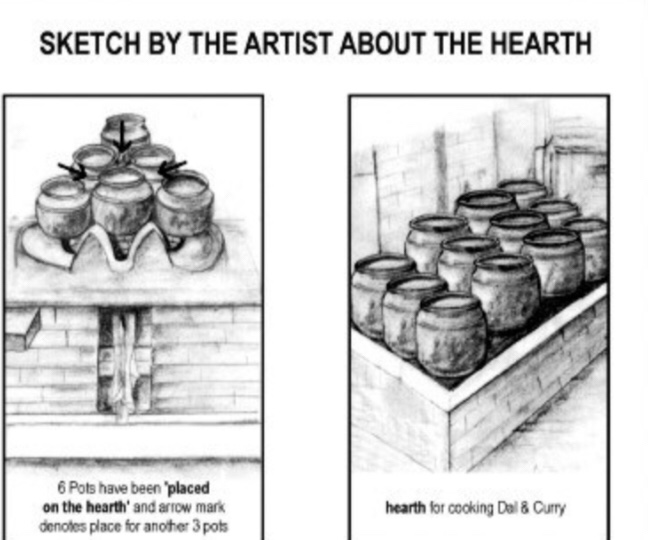
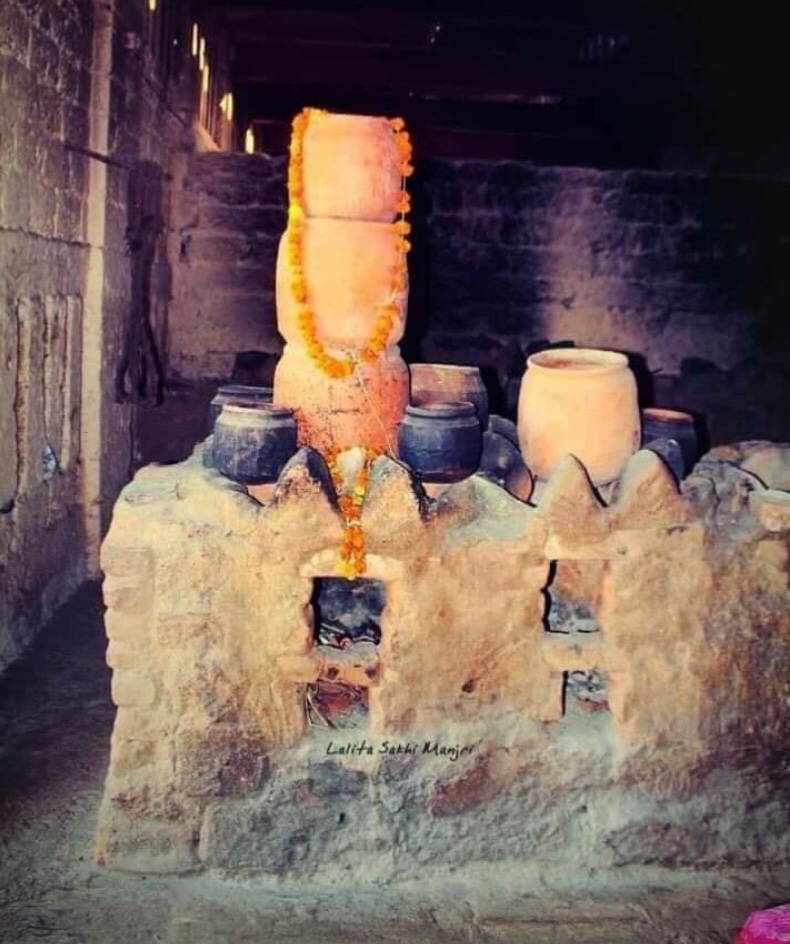
Firewood used in the kitchen
The wood to be selected should not have been eaten by pest, and nails must not have been pierced into the wood and they should not be very hard .The variety of local wood are preferred.
Vegetables not allowed for cooking in the temple
Usually Potato, tomato, drumsticks, ladies finger, onion, garlic, green chillies, red chillies, cauli flower, cabbage, bean, bitter gourd and capsicum is strictly prohibited for use in the kitchen while preparing this Mahaprasad.
Hygienic maintenance of the kitchen
To keep the kitchen hygienic and make the food preparation as holy offering to the Lord strict discipline is maintained inside the kitchen. The following principles are followed strictly inside the kitchen.
a) The cook has to come inside the kitchen only after taking bath.
b) The cook has to wear neat and clean cloth.
c) The cook cannot grow moustache or beard.
d) The cook cannot wear iron ring or thread round the arm.
e) They cannot chew paan (Betel) or any type of intoxicating material.
f) They should not sing or shout or crack jokes inside the kitchen.
g) While carrying cooked food they have to wear a cloth mask around the mouth.
h) Mobile and other electronic devices and camera is strictly prohibited for use inside the kitchen.
Can more than 1 lakh people take food on a single day?
This is a pertinent question which baffles the general public. If scientific and mathematical analysis is made it is proved to be correct. Sri Biswanath Samantara, the Secretary of the Badu Suar Nijog (Secretary, Temple Cook Association) in course of interview confirmed that rice inside the kitchen takes 12 minutes to get prepared and dal as well as curry also takes 13 toto 15 minutes to get ready once they are placed on the hearth.
As per the procedure, on one hearth for cooking rice 9 Matha kudua (pot for food intake for 10 to 12 persons are placed and after 12 minutes the cooked rice is put from Matha kudua to the Bai handi (Biggest pot which can feed around 100 people). If we take the process of cooking and transferring to the bigger pot as 15 minutes then the numbers of people who can be fed in 15 minutes are 100. There are 175 hearths of this type which means in course of 15 minutes rice gets ready for 17,500 people. Similar is the case for dal and varieties of curry. They are placed on a rectangular hearth on the burning charcoal taken from the rice hearth as the base for cooking and surprisingly the dal and curry gets ready within 15 minutes from the 45 hearths where the number of pots that can be kept is 1215 (45 hearths x 27 pots per hearth) which can be consumed by 300 to 400 people.
This means that the food that can be prepared within a span of 15 minutes can be offered to 1750 people. The kitchen starts at 9 AM and the Prasad for general public to be supplied after it is duly offered to Lord is fixed at 11.30 AM which means the cooks get around 2 hours and 30 minutes. If in each 15 minutes the kitchen can cook food for 17,500 people then mathematically within a span of two and half hours food can be made for 1,75,000 people. Thus there is no exaggeration to the saying that the biggest kitchen can feed more than 1 lakh people.
On an average 25,000 to 30,000 people visit Puri temple daily. On Saturdays and Sundays and other holidays it goes up to 40,000 to 50,000. But on special festive days the pilgrims’ entry exceeds 1 lakh. This happens on the marriage days or sacred thread ceremony days when there is special request for food for mass eating. One order can be for more than 1000 people. Order also comes from nearby rural areas who take it to the village to serve to the guests on various social occasions.
Why it is called Mahaprasad?
It is called Mahaprasad because food prepared is given Shadang (six) samskara which is not found in any other temples in India. The following are the shadaang samskara :
1. After Abakash, surya puja, yagna is done in Roshaghara, fire is taken for cooking from that yagna which is called Vaishnavagni. It is said that cooks never should think that they are cooking, therefore cooking is started in Vaishnavagni by Mahalaxmi. Mahalaxmi herself cooks in the kitchen.
The six deities shown above are the Avarana(encloser) deities of Agni. The oven is lighted according to Vaishnavagni rites. Here Laxmi is imagined as Ritumati and narayana is imagined as having united with her. By this the fire is generated and with this fire cooking is performed. As per the nine divisions of diagram, nine erathen pots are placed on an oven having nine mouths.
2. The food was served to the Deities on a golden or silver plate (now plates are made of brass) is kept on top of the Sri yantra (made with ground rice powder) near the Ratna simhasana.
- The three plates are empowered with the bijas for the three Deities: shrim for Bada Thakura, hrim for Subhadra, klim for Jagannatha.

3. The water used for the ablution is empowered with the Patala Nrisimha Mantra.
(4) The Prasad is offered in the Ashtadashaksha Gopal Mantra.
5) Samarpana of Prasad to the supreme Bhairavi Bimala on Bhairavi chakra.
6) After being offered to Vimala, the Annabali is offered to the eight Sattvika Vaishnavas: Visvakshena, Sukadeva, Prahlada, Narada, Hanuman, Garuda, Devala and Indradyumna.
Only at this point the food is known as Mahaprasada.
There is an interesting legend about this. When King Indradyumna finished erecting the temple, he went to invite Lord Brahma to come and consecrate the edifice. It took a long time as Brahma was in meditation. When he came back, another goddess, Vimala, had already taken possession of the massive temple. She agreed to vacate the abode if another temple for her was built in the same courtyard and that she would be the first to receive the god’s food leftovers. She was appeased and the tradition is being maintained since then.
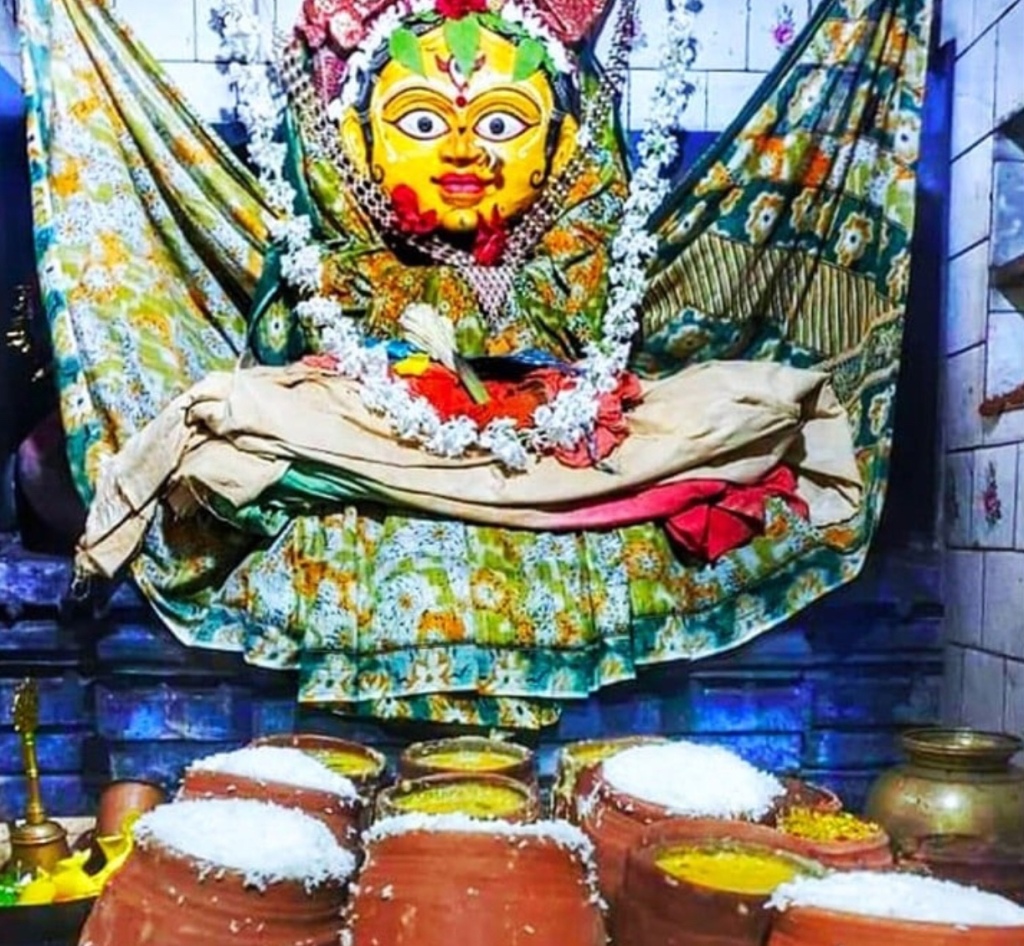
Afterthe dishes cooked and prepared inside the kitchen, they are brought before the deities by the suaras and mahasuaras. While carrying the bhoga, the closely wrap their mouth so that no
spit or saliva or even the direct breath can contaminate the dishes. They almost move in aline from the kitchen to the sanctum,the bhoga is placed at the Pokharia in-front of deitieswithin the three rectangles drawn with colored powders called as Muruja. A small portion of
the bhoga placed at pokharia in earthen pots is taken in a metallic plate and placed on the Ratnavedi along with the required upachara (16 upachara in sakala dhoopa, madhyana dhoopa and sandhya dhoopa) offered to deities. It is in fact the actually bhoga offered to
deities as Naivedya where the rest is considered to be symbolically sanctiUed. After puja, the prasad of the metallic plate is again taken to the sanctum of Goddess Bimala and is offered to her. Only after this it is termed as Mahaprasada.
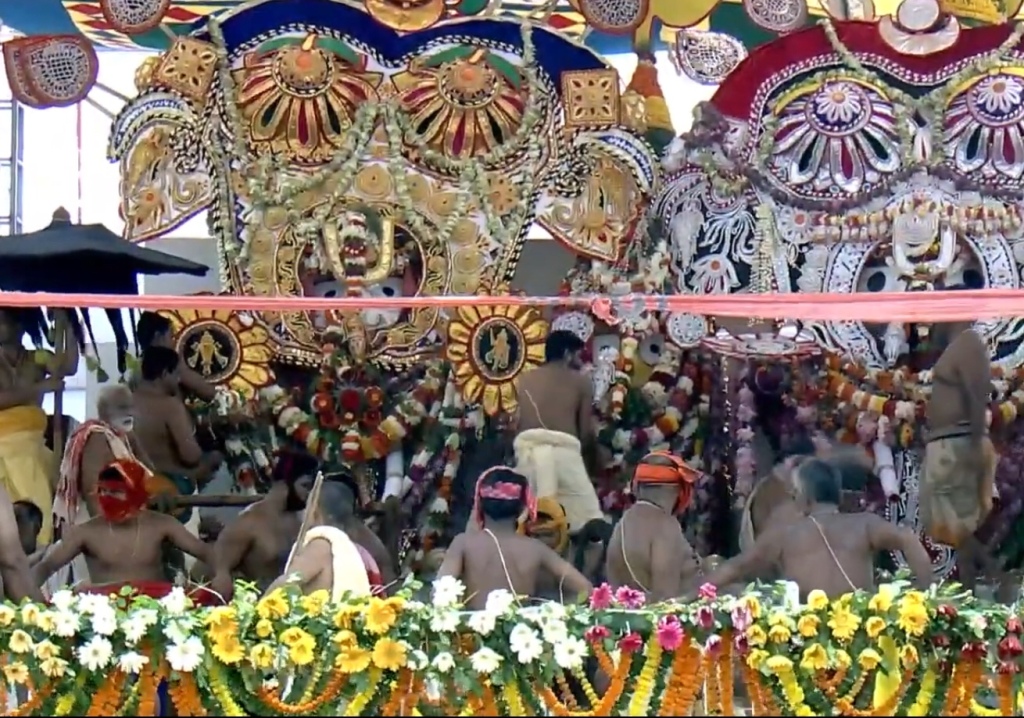
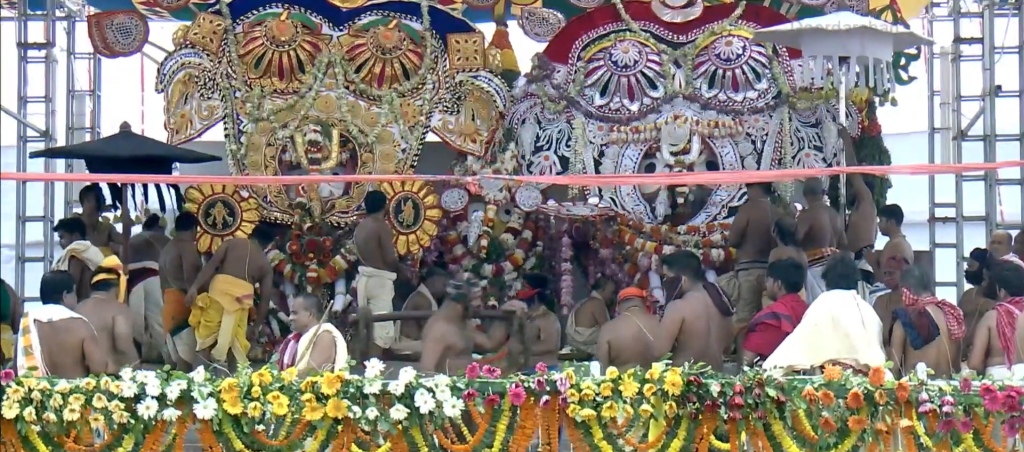
There are two different passages that the food out from the kitchen are. The first one has been offered in bhoga mandapa for larger kotha bhoga and chatra bhoga. The other one offers inside the interior sanctuary of the temple known as kotha bhoga.
The food then becomes Mahaprasad (divine offering) which is made available in an open market. Ananda Bazar, located to the North-east of the Singhadwara inside the Temple complex is a place where devotees queue up to buy in portions.
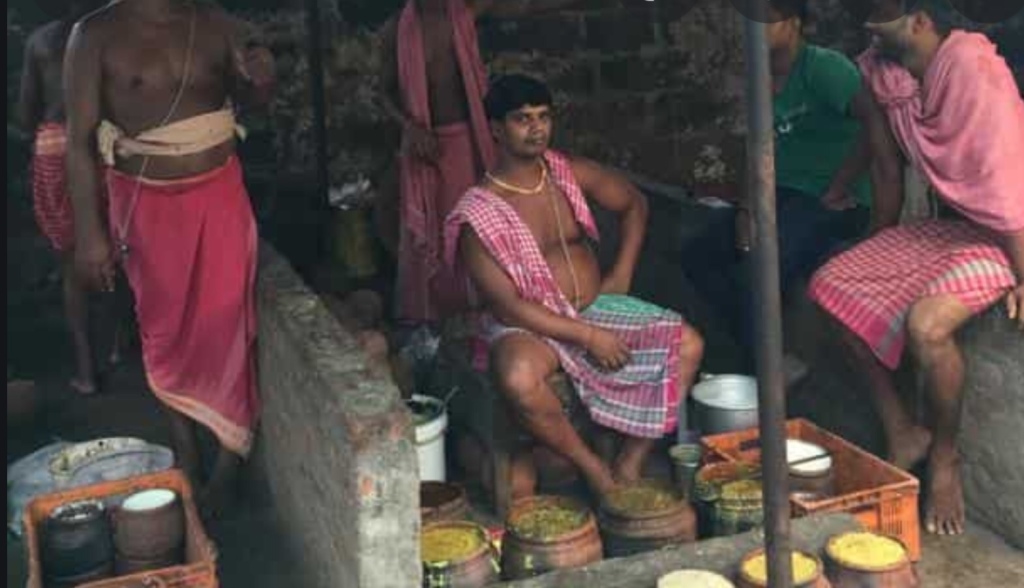
Frequently also said that if Maa Lakshmi is incensed with the preparations by the cooks, a dog will appear curious on the temple floor. If the dog is spotted, all the food must be buried and ready again. As a result no dog is allowed to invade the temple boundaries. This dog is supposed to be Kutama Chandi. She is a tantric goddess responsible of purification of food and temple premises.
In Brahma Purana, it is mentioned that “Naibedya puratonyasta drusteiba swikrutam maya, Bhakatsya rasangrena rasamashnami padmaja”It means “The Lord tastes and feasts the MahaPrasada through His devotees”.
Puranic View of Mahaprasad of Lord Jagannath
Skanda Puran:
Skanda Puran said that after eating Mahaprasad one can overcome “Maya” and get “Moksha” in life.
Padmapuran:
The Padmapuran mentioned that if anybody is not satisfied after partaking the Mahaprasad. Then he will deem spiritually treacherous and sinful of Lord Vishnu.
Mahanirban Tantra:
It mentioned that all are equal. There is no caste and religion while partaking Mahaprasad. It has no grade or class. Refusal to taking Mahaprasad is a kind of sin that can’t be atoned.
Chaitanya Charitamrita:
Sri Chaitanya describes that after partaking Mahaprasad he released from material bondage. He obtained the blessing of supreme power.
Bramha Puran & Purusottam Puran:
It mentioned that if one can take a holy bath in the Puri Sea. After that, they will offer Pinda Dana to their ancestors at Baisi Pahacha (22 steps) with Mahaprasad. They will get the result of DasaswaMedha Yajna in their life.
Need to follow the rule during Partaking of Mahaprasad
- Any other food item need not taken with Mahaprasad.
- Should avoid walking on the place where Mahaprasad is fallen.
- Need to first touch your head with Mahaprasad before eating.
- Should not clean the hand or mouth after taking Mahaprasad in a dairy place.
- Should sit in any Asana while Partaking Mahaprasad
Mahaprasad of Jagannath temple Puri is priceless. The Mahatma of MahaPrasad is Inexplicable. The importance and greatness of Mahaprasad described in 24 different MahaPurans and Sastras.
It believed in Jagannath Sanskriti that if Mahaprasad or Nirmalya given to a person on his death bed. He is sure to have a place for himself in heaven after his death.
Daily thousands of Pilgrims and devotees had eaten Mahaprasad in Ananda Bazar. There is no casteism. It creates a brotherhood relationship among the peoples in the society.
Source:
Jagannthsanskriti.in
Medium.com
Ashish Sarangi
Magazine.Orissa.gov.in
Bong Kalinga tales YouTube
Jai Jagannath 🙏
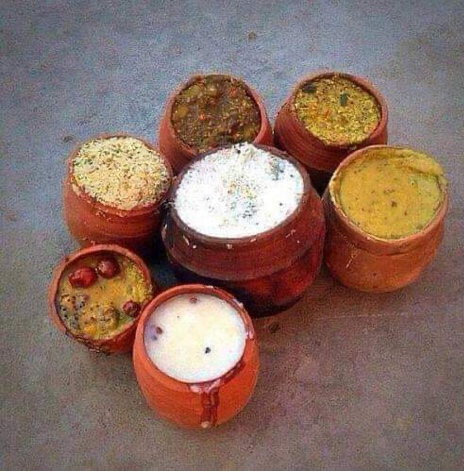
I would like to thank you very much for such detailed and valuable information.
LikeLike
Thank you for your word of appreciation 🙏
LikeLike